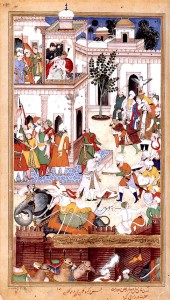City Dwellers: Contemporary Art from India at the Seattle Art Museum
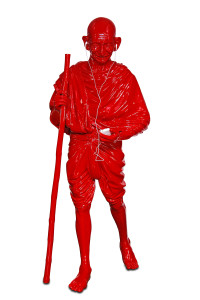
Debanjan Roy,India Shining V 2008, fiberglass with automotive paint, 66 x 32 x 36”, Collection of Sanjay Parthasarathy and Malini Balakrishnan. ©Debanjan Roy, Photo courtesy Aicon Gallery.
GANDHI WITH AN IPOD!
A life size red fiberglass figure of Gandhi painted with glitzy red automobile paint and holding an iPod leaps out at us in the first gallery of “City Dwellers, Contemporary Art From India,” works on generous loan to the Seattle Art Museum from the collection of Sanjay Parthasarathy and Malini Balakrishnan.
Debanjan Roy’s sculpture defiantly alters our image of the humble white-garbed Gandhi. We are a long way from the non-violent Gandhi, who was murdered in January 1948 in the aftermath of the extreme violence of the Partition of India and Pakistan. (See the film Earth by Deepa Metha for a potent telling of that time). The red color of this sculpture refers to that violence; the shiny synthetic material refers to the contemporary reality of India, commercial, business oriented, and materialistic: the antithesis of everything that Gandhi believed in and lived.
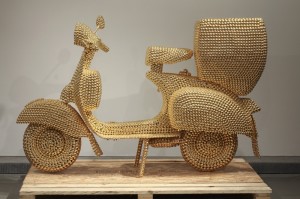
Scooter, 2007, Valay Shende, Indian, b. 1980, welded metal buttons, 45 x 70 x 30 in., Collection of Sanjay Parthasarathy and Malini Balakrishnan. © Valay Shende
Valay Shende’s gold studded motorscooter is a magnificent statement that belongs also in the concurrent Pop Art exhibition at the Seattle Art Museum. It is popular culture glorified with gold. Shimmering, tactile, and seductive in its generous curves, we can visually immerse ourselves in this scooter with its mixture of the modern and the contemporary.
All of the work in this exciting exhibition plays with the past and present, upsets clichés and fixed romantic notions of India, and provides insights into where this huge and dynamic country is today. At the same time, it is clear that all of these artists have great reverence for their own history, both cultural and historical. I can’t help envy contemporary artists in India for the enormous wealth of cultural references at their disposal.
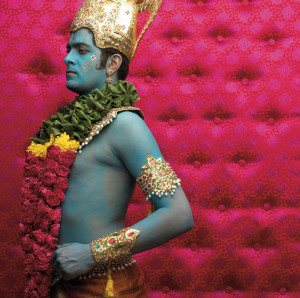
Reassurance, from the Definitive Reincarnate series, 2006, Nandini Valli Muthiah, Indian, b. 1976, color photograph, 40 1/4 x 40 x 1 in., Collection of Sanjay Parthasarathy and Malini Balakrishnan. © Nandini Valli Muthiah
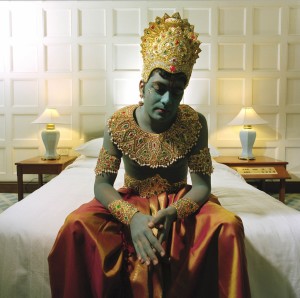
Disillusioned, from the Definitive Reincarnate series, 2003, Nandini Valli Muthiah, Indian, b. 1976, color photograph, 40 1/4 x 40 x 1 in., Collection of Sanjay Parthasarathy and Malini
Nandini Valli Muthiah places the blue-skinned Krishna in contemporary surroundings. In contemporary India, Krishna frequently appears in full size statues and reenactments in religious processions. Here we see him up close and brooding. We can see the intricate details of his costume, the painted blue of his skin, and a glimpse of his inner life. The juxtaposition of myth and reality is deeply moving. Muthiah conveys the burden and responsibility and perhaps the inspiration of renacting Krishna in these unusual photographs.
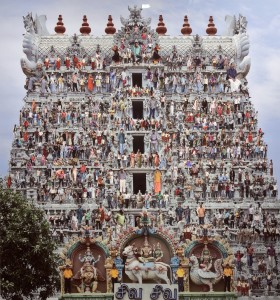
Include Me Out II, 2011, Vivek Vilasini, Indian, b. 1964, inkjet photographic print, 68 1/4 x 64 1/4 x 2 in., Collection of Sanjay Parthasarathy and Malini Balakrishnan. © Vivek Vilasini
Vivek Vilasini photographed dozens of people seemingly standing on an historical façade of a Hindu temple in South India. If we look closely we see a catalog of contemporary Indian people from school children in uniforms to women in saris. The artist himself sits near the top in contemporary dress. Vilasini seems to have been able to pose all of these people in such a way that we are convinced they are actually standing on the narrow ledges of the temple where the gods and goddesses of the Hindu pantheon have cavorted for centuries. Goodbye Hindu gods, hello contemporary India
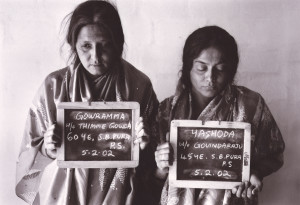
Criminals (after 2001 newspaper photograph), from the project Native Women of South India: Manners and Customs, 2000-2004, Pushpamala N., Indian, b. 1956 with Clare Arni, British, b. 1962, C-print, 15 x 22 in., Collection of Sanjay Parthasarathy and Malini Balakrishnan. © Pushpamala N., Photo courtesy Nature Morte, New Delhi
Pushpamala N and Clare Arni perform and restage publicly available imagery from historical paintings to police mug shots and, of course, Bollywood posters. So effectively are they re-created that you always have to look twice to know that they are not the real thing. Their work is political: they are looking at female clichés, oppresions, and assumptions by foreign photographers who romanticize India. Here is a provocative analysis of her work and other artists in the exhibition.
One of the most fascinating photographs in this series is the Tamil leader who is also a film star reenacted by the artist, based on a magazine cover. So we have several layers , and a deep reflection of politics and power as a performance both by Pushpamala N and by Jayalalitha, the film star who became a Chief Minister of Tamil Nadu. She was recently arrested and is just out on bail this month.
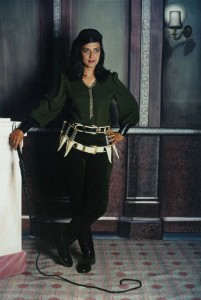
Pushpamala N., ‘Cracking the Whip (after 1970s Tamil film still)’. From the photo-performance project Native Women of South India: Manners and Customs, 2000-2004. Type C-print on metallic paper, 20 x 24 inches. Collection of Sanjay Parthasarathy and Malini Balakrishnan. © Pushpamala N.,
Manjunath Kamath’s amazing triptych, of which we have only the center panel here, has a dizzying array of references. Looking at it is a treasure hunt to see what we can spot. But before descending into the details the overall coherence of the piece dominates, the artist plays with perspective space in a way that corresponds to the compicated spaces of sophisticated Mughal painting that show interiors and exteriors, gardens and landscape, near and far all at once.
I can easily spot some of the cultural references: Superman, and Picasso, and tourists taking pictures. But there are other references I would like to know more about. I particularly love the juxtaposition behind the sofa of Christ, the bull and the red uniformed Chelsea Pensioner ( identified immediately by my British born husband).
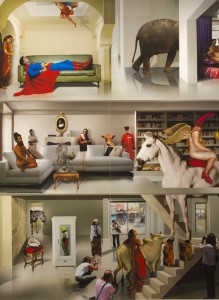
Overdose, 2009, Manjunath Kamath, Indian, b. 1972, color photograph, middle panel: 95 1/2 x 72 x 2 3/4 in (one of three) Collection of Sanjay Parthasarathy and Malini Balakrishnan. © Manjunath Kamath
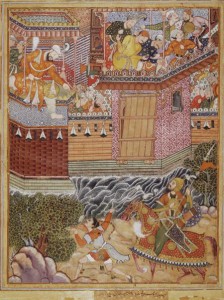
Hamza outside the Fortress of Armanus, 1567-82, Mir Sayyid ‘ali, Persian, active 16th c., opaque watercolor, ink and gold on paper, 34 15/16 x 28 3/4in. (88.8 x 73cm), Seattle Art Museum, Gift of Dr. and Mrs. Richard E. Fuller, 68.160
MUGHAL PAINTING POWER AND PIETY Asian Art Museum July 19 – December 7, 2014. The dazzling exhibition at the Seattle Art Museum is paired with Mughal Painting: Power and Piety at the Asian Art Museum, a small, but intense selection of miniature paintings along with objects similar to those that appear in the paintings, such as daggers, rings, and necklaces. This dialog of two and three dimensions is provocative, and helps us to look much harder at the tiny details of the miniatures (magnifying glasses are provided). Mughal painting initially was the result of the amazing rule (1556-1605) of the enlightened leader Akbar who unified India. He embraced Persian cultural traditions, as well as reaching out to include all religions, created a huge library with books in many languages, and brought artists, scholars, translators and holy men to his court.
Although he was a Muslim, he sought unity among different traditions. Akbar altered the course of Indian history and art in a way that lasted many centuries. In a brilliant lecture at the Asian Art Museum by LACMA associate curator of Islamic Art Keelan Overton ( who also curated the exhibition which will be followed by a second installment on Decmber 9) , we learned the ways in which these miniatures were put together in albums for the pleasure of the elite. Once you start looking, you can seem seems and additions, glued together just the way we make albums today.
Akbar’s ecumenical philosophy and Gandhi’s non violence have long vanished in India. Since Independence in 1947, sectarian violence has repeatedly erupted in India to devastating results, but today, the religion of capitalism is the dominant force and focus of disruption. These contemporary artists provide us with both critique and humor. A fiberglass Gandhi with an iPod? Krishna in a four star hotel room? Makes perfect sense.
This entry was posted on November 11, 2014 and is filed under Art and Activism, Art and Politics Now, Contemporary Art In India, Film, Performance Art, Photography, Picasso, Seattle Art Museum, Uncategorized.

